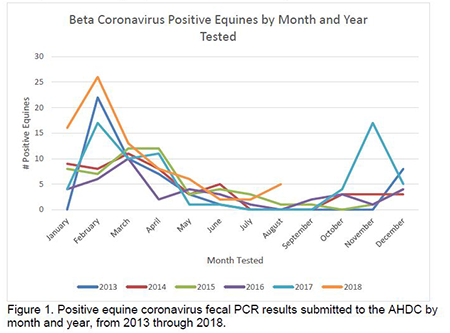Equine Coronavirus Cases
(North America) The Cornell University Animal Health Diagnostic Center (AHDC) has seen a rise in the diagnosis of equine enteric coronavirus cases since initial outbreaks were investigated starting in 2010. The AHDC Veterinary Support Services veterinarians are attributing this increase in equine enteric coronavirus in our area of the Northeast to improved awareness of the disease and therefore diagnostic submissions. Since 2013, nearly 2000 samples have been submitted to the AHDC for equine coronavirus testing, of which approximately 18% have tested positive.
Equine coronavirus is commonly seen during the cold weather months, October through April, but cases are also diagnosed in the heat of the summer.

Equine coronavirus manifests as an enteric disease in the horse, with common clinical signs of fever, anorexia, lethargy, soft manure and mild colic. Transmission of equine coronavirus is via the fecal-oral route. Clinical signs of equine coronavirus are seen 48-72 hours after exposure and fecal viral shedding begins 3-4 days after exposure.
Clinical signs generally resolve in several days to 1 week with supportive care. The sample for equine coronavirus testing is fresh feces for equine enteric coronavirus PCR submitted in an unbreakable leak-proof container to the laboratory by overnight courier on ice packs.
For more detailed information, please visit Equine Coronavirus protocols.


